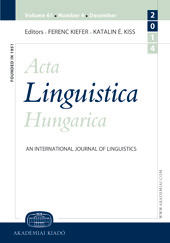Ways of Licensing Hungarian External Possessors
Ways of Licensing Hungarian External Possessors
Author(s): Katalin É. KissSubject(s): Language studies, Finno-Ugrian studies, Philology
Published by: Akadémiai Kiadó
Keywords: external possessor; internal possessor; possessor movement; possessor topicalization; possessum incorporation;
Summary/Abstract: This paper examines the status of Hungarian dative noun phrases interpreted as external possessors of a sister constituent. It challenges the widely accepted view put forth by Szabolcsi (1983; 1992, etc.) that external possessors are uniformly assigned a theta role by the possessum, and they are uniformly raised from its maximal projection via A-bar movement. It argues instead that external possessors can also be base-generated outside the projection of the possessum, binding its internal possessor, and can receive an ‘affected’ theta role from the verb. The paper distinguishes three different types of external possession, showing that they have different licensing conditions, and different agreement properties. (i) The external possessor can be generated externally, and be assigned an ‘affected’ theta role by the verb. The referential identity of the dative marked affected participant and the pro-dropped internal possessor is due to a binding relation between them. (ii) The external possessor can be licensed by information structure/logical structure: a case marked possessor can assume a topic, focus, or quantifier role on its own, and can be raised into the corresponding A-bar position independently, without its possessum. (iii) The external possessor can also be licensed by the semantic incorporation of its possessum. External possessors binding a pro and external possessors binding a trace in the projection of the possessum elicit different agreement on the possessum. The choice of agreement in the different types of external possession constructions has been tested with 40 native speakers, and the results have been used as evidence in their structural analyses.
Journal: Acta Linguistica Hungarica (Since 2017 Acta Linguistica Academica)
- Issue Year: 61/2014
- Issue No: 1
- Page Range: 45-68
- Page Count: 24
- Language: English

